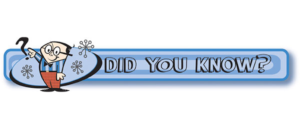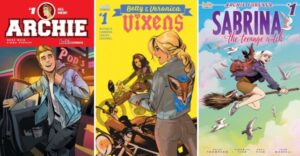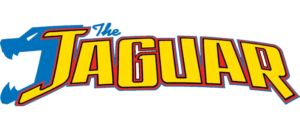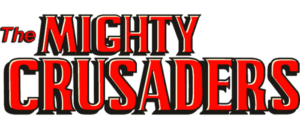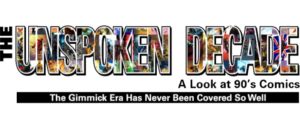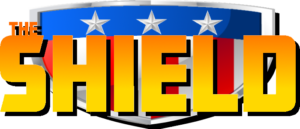BORN ON THE FOURTH OF JULY
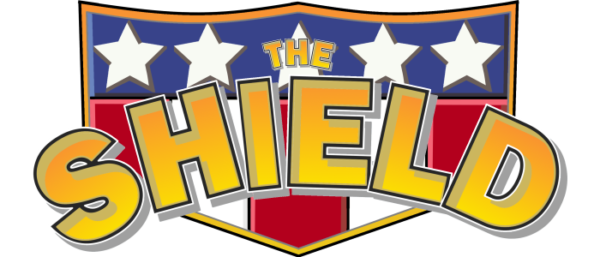
This article can be seen with reference art at moviepoopshoot.com/comics101/19.html
COMICS 101
By Scott Tipton
July 2, 2003
BORN ON THE FOURTH OF JULY
Here it is nearly Independence Day, and I’ll bet you think you know what’s on the agenda. “Fourth of July, right? Gotta be Captain America.” Think again, class. We here at COMICS 101 loathe being predictable, so instead, today we’ll be covering every patriotic super hero to hit the funnybooks except Captain America, and save good ol’ Cap for, I don’t know, Bastille Day, or some other holiday we can rightfully ignore. So settle in for a whirlwind tour of red, white and blue mystery men and women, some considerably more well known than others. Let’s begin with the granddaddy of them all, the very first star-spangled super-hero. And just to reiterate, I’m not talking about Captain America.
Very few comic fans realize it, but Timely’s Captain America was not the first of the flag-wearing superhero set. That honor goes to The Shield. Ever heard of him? Didn’t think so. The Shield first appeared in the pages of PEP COMICS #1, published by MLJ Comics (the publisher that would eventually become Archie Comics) in January 1940, well over a year before Captain America’s first appearance in 1941.
The Shield was created by MLJ editor Harry Shorten and artist Irv Novick, probably best known for his work on BATMAN some 35 years later. In the story, scientist Tom Higgins has devised a formula to grant superpowers to normal humans. Just as he completed his work, Tom Higgins was murdered by mysterious foreign agents. Higgins’ son Joe was thus inspired to test the process out on himself, gaining steel-hard skin and super-strength. Crafting a uniform for himself based on the American flag, Joe Higgins becomes The Shield, and unlike most super-types who decide to go freelance with the whole crimefighting thing, promptly reports to FBI boss J. Edgar Hoover to offer his services.
The Shield was popular enough to earn a second magazine he shared with fellow MLJ hero The Wizard, the logically named SHIELD-WIZARD COMICS beginning in Summer 1940.
In time, The Shield gave in to the craze for boy sidekicks that was sweeping comic books after the success of Robin in the Batman comics, and soon found himself partnered up with … Dusty the Boy Detective. Pretty unremarkable stuff. By the mid-‘40s, The Shield was muscled out of PEP COMICS by Archie and his teen gang, and that was it for Joe Higgins. Archie Comics tried reviving The Shield a couple of times, once in reaction to DC’s Silver Age success, and again in the mid-60s after Marvel hit it big, but neither series took off. DC licensed The Shield and the rest of Archie’s superhero characters in 1991 for their new Impact! Comics imprint, but that too was gone little more than a year later.
Quality Comics had much better luck with their flag-waver, Uncle Sam. First appearing in Quality’s NATIONAL COMICS #1 (August 1941), the Uncle Sam strip was a product of Will Eisner’s shop, with most of the art being handled by Lou Fine. Primarily just a carryover of the “Uncle Sam” character made famous in Thomas Nast’s 19th-century political cartoons, the strip gained popularity thanks to the unabashed patriotism of wartime America and the gorgeous art of Lou Fine (as well as some fantastic covers by Will Eisner and Reed Crandall). Although an attempt was made to give Uncle Sam a superhero-type origin (something involving the Spirit of America merging with a Midwestern patriot), it wasn’t really necessary. It was the artwork and iconography that sold the strip.
When DC Comics bought up the Quality stable in the ‘60s, Uncle Sam was in the forefront, appearing along with Phantom Lady, Doll Man, Black Condor, the Ray and the Human Bomb (now dubbed the Freedom Fighters) first in guest appearances in JUSTICE LEAGUE OF AMERICA, then in their own book, FREEDOM FIGHTERS, which premiered in March/April 1976. The FREEDOM FIGHTERS book only lasted 15 issues, and then it was back to guest-star limbo for Sam and company. Uncle Sam still pops up from time in the DC Universe, although I think at last sight he had been transformed into a more futuristic character called the Patriot. It won’t last; that costume is too good to lose. Besides, he’s one of the few characters on this list with his own action figure…
Also making her debut appearance in MILITARY COMICS #1 was Miss America, a.k.a. reporter Joan Dale, who was granted magical powers by the spirit of the Statue of Liberty. Riiiiiight.
The Miss America stories didn’t have quite the same punch as the Uncle Sam adventures, and her run in MILITARY COMICS lasted a scant 7 issues. Although the Miss America strips were pretty run-of-the-mill, she did sport a pretty snazzy costume. She was later somewhat awkwardly shoehorned into DC history (and the Justice Society of America) when it was realized that a new post-CRISIS Wonder Woman meant that there had never been a Wonder Woman in the 1940s adventures of the JSA. DC’s writer/editor Roy Thomas tried to make do with Miss America as a Wonder Woman replacement, but fans never really bought the concept, and it’s been all but abandoned in recent years.
When Quality abandoned the Miss America concept, Timely quickly snatched it up with their own version of Miss America, making her first appearance in MARVEL MYSTERY COMICS #49 (November 1943).
In the Timely version, Miss America was Madeline Joyce, a liberty-loving teenager with a thirst to fight for justice, who finds herself granted physical strength and the ability to fly by strange experiments with electricity conducted by a mysterious scientist working for her millionaire uncle. Timely’s only significant super-heroine, Miss America was successful enough to warrant her own title, although she was soon overshadowed in the pages of MISS AMERICA COMICS by the adventures of teen Patsy Walker. Miss America (along with Captain America and Bucky, the Human Torch and Toro, the Sub-Mariner and Timely’s Flash knockoff The Whizzer) also appeared in Timely’s short-lived postwar superhero team series, the All-Winners Squad, which garnered only two appearances in ALL-WINNERS COMICS. Miss America was later revived, much like every other Golden Age character who ever appeared, by Roy Thomas, but appeared only in WWII-era stories and flashback sequences in the pages of THE AVENGERS.
National Comics had their own pack of all-American heroes. The most popular was probably the Star-Spangled Kid and Stripesy. First appearing in ACTION COMICS #40, the most notable thing about the series was the reversal of the hero/boy sidekick concept: here, the kid was clearly in charge, while the adult was the one following orders.
In their debut, readers met Sylvester Pemberton, young son of a high-society prominent millionaire, and Pat Dugan, a working-class auto mechanic. After Pemberton and Dugan fight off pro-Nazi agents at a local movie house, they both overhear an offhand remark that “it’s too bad the flag can’t come to life and rout those Nazis,” and independently have the same idea: to bring Old Glory to life and fight for their country. They each craft patriotic costumes for themselves, Pemberton becoming the Star-Spangled Kid, and Dugan dubbing himself Stripesy. Eventually, the two become partners, and Pemberton arranges for his father to hire Dugan as the family’s chauffeur and in-house mechanic (just to make sure Stripesy knew his place, I guess).
The duo had no superpowers to speak of, just their fists and the Star-Rocket Racer, a souped-up flying car designed and built by Dugan.
The Kid and Stripesy were also members of National’s team of second-string superheroes, the Seven Soldiers of Victory, alongside the Green Arrow and Speedy, the Crimson Avenger, the Shining Knight and the Vigilante. The Seven Soldiers comics were pretty mediocre, and they soon lost their spot in LEADING COMICS to funny-animal comics.
The Star-Spangled Kid and Stripesy were revived in the Silver Age, where it was revealed in the pages of JLA that the team had been lost throughout time since the ‘40s, and had barely aged since the end of WW II. The Kid was given superpowers through a high-tech belt device (the “Cosmic Converter,” to be precise) and appeared throughout the ‘70s and ‘80s in both Justice Society guest shots and as the leader of INFINITY, INC., a team book made up of the children of JSA members; the Kid was murdered in the final issues of the series. Stripesy recently reappeared in the pages of STARS AND S.T.R.I.P.E., in which he had to contend with his teenage stepdaughter Courtney, who had found the late Pemberton’s power belt and taken it upon herself to become the new Star-Spangled Kid.
An exceptionally fun series with scripts by Geoff Johns and art by Lee Moder, STARS AND S.T.R.I.P.E. unfortunately only lasted 15 issues, although Johns transferred the Courtney character over to JSA, where she remains a big part of the series. Pick up those STARS AND S.T.R.I.P.E. back issues if you see them; very good stuff.
National was also home to Mr. America, who first appeared as “Tex Thomson” way back in ACTION COMICS #1 in 1938. Thomson was a world adventurer type who was turned into a superhero in ACTION COMICS #40, when National realized just how popular the superhero craze had become.
When Thomson was believed killed by foreign agents on a mercy mission at sea, he returned as Mr. America, leaving red, white and blue feathers as his trademarks and whistling “Yankee Doodle.” As if that wasn’t quite silly enough, Mr. America had an overweight sidekick named “Fatman,” who wore a lampshade on his head as a mask. Yeesh. Mr. America underwent another change in ACTION #54, when he accepted an assignment from FDR for overseas espionage duty and became the Americommando. The Americommando’s adventures were just as unremarkable as Mr. America’s and he quickly faded into obscurity.
A little more popular was Liberty Belle, National’s only other major female superhero. First appearing in BOY COMMANDOS #1 before settling into a lengthy run in STAR-SPANGLED COMICS, Belle was really Libby Lawrence, a radio commentator who took on the identity of Liberty Belle to fight subversives and Nazi agents on the homefront.
Liberty Belle’s only powers came from a tiny replica of the Liberty Bell on her belt, made from the Bell itself, which would grant her a temporary burst of strength and speed when the original Liberty Bell was rung. Good thing she knew the guard in Philadelphia, I guess … Liberty Belle was revived, along with every other Golden Age hero in the National and Quality rosters, by Roy Thomas in the 1980s for membership in the WW II-era ALL-STAR SQUADRON series, which united every World War Two superhero into a single team under the command of President Roosevelt. Another good series to look for in back issues…
In the 1950s, Captain America creators Joe Simon and Jack Kirby tried to recreate the magic, this time with a satirical bite with Fighting American, a parody of their old Captain America strips with a distinctive Cold War edge.
The Red-bashing Fighting American and his sidekick Speedboy, first published by Prize Comics in 1954, went toe to toe with such menaces as Hottsky Trottsky, Super Khakalovich, Rhode Island Red and Poison Ivan.
Although critically acclaimed in years to come, Fighting American never really went over big with comic readers of the time. More recently, when Marvel successfully sued Rob Liefeld over the similarities between his proposed AGENT AMERICA series and Marvel’s Captain America, Liefeld acquired the FIGHTING AMERICAN license and retooled his series to match the terms of the lawsuit, but Liefeld’s new Fighting American came and went in 1997 after 8 issues total, with barely a peep from the marketplace.
In more recent years, both DC and Marvel have introduced a few new star-spangled super types. In 1978, DC introduced Steel, a World War II-era cyborg battling the Nazis both abroad and on the home front.
As described in STEEL #1, U.S. Marine Hank Heywood volunteers to undergo his mentor’s bioretardant process to rebuild his body after he’s critically wounded in an attack on his military base. As a result of the procedure, Heywood’s pulped bones and skull are enshrouded in steel casings, and micro-motors are implanted in his joints to allow him to move the weight of his new steel skeleton. In addition, the “bioretardant formula” was used to induce skin growth over most of Heywood’s charred body. At the end of the ordeal, Heywood had become “Steel, the Indestructible Man.”
Steel’s comic only lasted five issues; he made a few appearances in ALL-STAR SQUADRON, where he was dubbed “Commander Steel,” but that was about it. Later, Hank Heywood resurfaced as an old man in the pages of JUSTICE LEAGUE OF AMERICA, where it was discovered that the old crank had subjected his grandson to the same procedure (seemingly unnecessarily, which is pretty creepy when you think about it), and offered the then-down-on-its-luck JLA a state-of-the-art headquarters if they would accept his grandson, the new Steel, as a member.
They agreed, and young Hank Heywood III paid the price, as the neophyte hero was murdered by longtime JLA enemy Professor Ivo not long after his induction.
One of the funnier treatments of American-based characters by DC Comics can be found in the pages of BATMAN AND THE OUTSIDERS, a relatively short-lived team book combining Batman with disparate DC characters both old and new. Written by Mike W. Barr and drawn primarily by Jim Aparo (and later, Alan Davis), BATMAN AND THE OUTSIDERS is probably best known for its wildly colorful and cartoony villains. Case in point: The Force of July, a top-secret government strike force that wrongly believes Batman and his new teammates to be anti-American subversive agents. This bunch was a sure sign of how things had changed in comics by the 1970s and ‘80s: you’d never see a bunch of symbolically American characters used as villains in the Golden or even Silver Ages.
For those keeping track at home, the Force of July consisted of team leader Major Victory, Lady Liberty, Mayflower, Sparkler and Silent Majority. Hey, if you think these guys are goofy, remind me to tell you about the Nuclear Family or the Duke of Oil sometime…
Most of Marvel’s more recent American heroes tie into Marvel’s long-running CAPTAIN AMERICA series. Two extremely obscure characters, the Spirit of ‘76 and the Patriot, were both revealed to have filled in for Captain America when the original, Steve Rogers, was missing in action at the end of World War II (frozen in a block of ice, as it turns out. But we’ll get to that in a month or so…).
In a popular 1980s CAPTAIN AMERICA storyline, after Steve Rogers refuses to take orders directly from the U.S. government, the feds repossess his uniform and shield and hand them over to John Walker, also known as Cap’s headline-hungry adversary the Super-Patriot, who is hired as the replacement Captain America.One of Walker’s confederates is also hired by the government, and swiftly dubbed Battlestar.
Rogers assumes a new costumed identity, meanwhile, in a uniform similar to his traditional outfit. After Walker turns out to be a loose cannon and is cut loose by the government, they publicly return the uniform and shield to its rightful owner, and then quietly secure the new uniform from Steve Rogers, which they then give to Walker, who continues to work for the government in a quieter capacity as the U.S. Agent.
Although Battlestar seems to have faded into Marvel Universe obscurity, the U.S. Agent can still be seen appearing in various series from time to time.
Before anybody e-mails, yes, Scott realizes he failed to include Yankee Poodle from CAPTAIN CARROT AND HIS AMAZING ZOO CREW. Gotta draw the line somewhere , I say. If you disagree, or have another question entirely, send it to Scott Tipton at stipton99x@moviepoopshoot.com.
Super Hero News <SuperHeroNews@hotmail.com> wrote:

